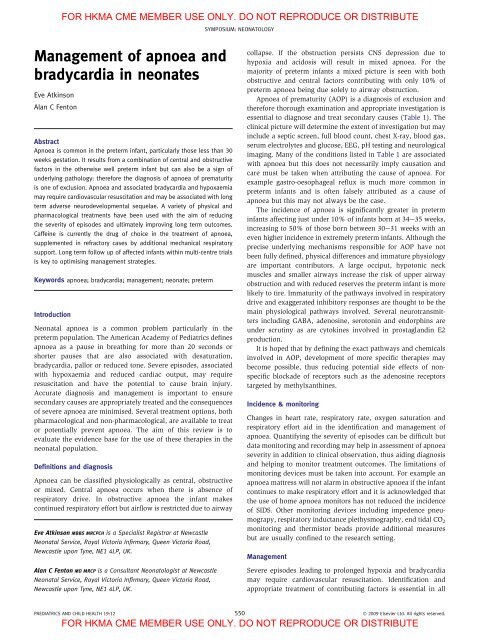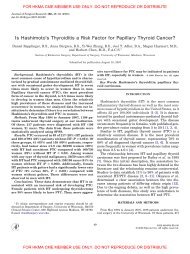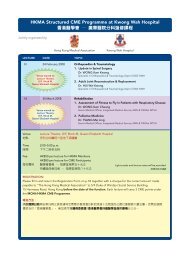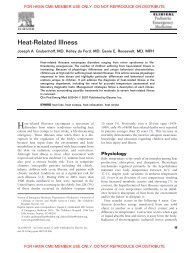Management of apnoea and bradycardia in neonates - Hkmacme.org
Management of apnoea and bradycardia in neonates - Hkmacme.org
Management of apnoea and bradycardia in neonates - Hkmacme.org
Create successful ePaper yourself
Turn your PDF publications into a flip-book with our unique Google optimized e-Paper software.
FOR HKMA CME MEMBER USE ONLY. DO NOT REPRODUCE OR DISTRIBUTESYMPOSIUM: NEONATOLOGYSecondary associations/causes <strong>of</strong> <strong>apnoea</strong>Infection (bacterial <strong>and</strong> viral)NeurologicalRespiratory/CardiovascularHaematologicalGastro<strong>in</strong>test<strong>in</strong>alDrugs (<strong>in</strong>fant <strong>and</strong> maternal)Acute/chronic pa<strong>in</strong>Airway malformationHead/body positionMetabolicTable 1Sepsis, men<strong>in</strong>gitis, NECIntracranial haemorrhageSeizuresAsphyxiaCongenital malformationsHypoxaemia, RDS, pneumoniaaspirationPDAHypovolaemia, hypotensionHeart failureAnaemiaGORDAbdom<strong>in</strong>al distensionOpiatesMagnesiumProstagl<strong>and</strong><strong>in</strong>sConsider drug withdrawalHypoglycaemiaHypocalcaemiaHypothyroidismHyponatraemiacases <strong>of</strong> neonatal <strong>apnoea</strong>. Additional respiratory support, physical<strong>and</strong> pharmacological treatments may also be required. Theaim <strong>of</strong> therapy is to reduce the severity <strong>of</strong> hypoxaemia <strong>and</strong>ultimately prevent adverse neurological outcome. It is thereforeimportant to ensure that short term ga<strong>in</strong>s are free from long termadverse effects. Ideally long term follow up <strong>of</strong> adequately poweredRCTs <strong>of</strong> available treatments would help to determ<strong>in</strong>e theeffectiveness <strong>of</strong> the many therapies available. Teas<strong>in</strong>g out theeffects <strong>of</strong> <strong>apnoea</strong> from other ‘prematurity associated factors’ isalso challeng<strong>in</strong>g. The ma<strong>in</strong>stays <strong>of</strong> therapies available are bothpharmacological <strong>and</strong> non-pharmacological each with vary<strong>in</strong>gamounts <strong>of</strong> evidence to support their use.Pharmacological treatmentsMethylxanth<strong>in</strong>es Methylxanth<strong>in</strong>es have been used as a treatmentfor neonatal <strong>apnoea</strong> s<strong>in</strong>ce the early 1970s. Their effectiveness<strong>in</strong> <strong>in</strong>creas<strong>in</strong>g m<strong>in</strong>ute ventilation, CO 2 sensitivity <strong>and</strong>diagphragmatic breath<strong>in</strong>g, whilst reduc<strong>in</strong>g periodic breath<strong>in</strong>g<strong>and</strong> hypoxic episodes is well documented. Caffe<strong>in</strong>e is now one <strong>of</strong>the most commonly used drugs <strong>in</strong> neonatal care. The effectiveness<strong>of</strong> caffe<strong>in</strong>e was demonstrated by a small number <strong>of</strong> studies<strong>and</strong> as a result few RCTs have taken place. A Cochrane review<strong>in</strong>clud<strong>in</strong>g 5 small studies (192 <strong>in</strong>fants) demonstrated a significantdecrease <strong>in</strong> <strong>apnoea</strong> <strong>and</strong> the need for IPPV <strong>in</strong> the first 2e7 days <strong>of</strong>life <strong>in</strong> those <strong>in</strong>fants receiv<strong>in</strong>g caffe<strong>in</strong>e compared to placebo or notreatment, with a second review demonstrat<strong>in</strong>g equal efficacywhen compared to theophyll<strong>in</strong>e. The much wider therapeutic<strong>in</strong>dex, once daily dos<strong>in</strong>g, reduced side effect pr<strong>of</strong>ile, <strong>in</strong>creasedCSF penetration <strong>and</strong> equal efficacy has favoured the use <strong>of</strong>caffe<strong>in</strong>e over theophyll<strong>in</strong>e or am<strong>in</strong>ophyll<strong>in</strong>e.The mechanism <strong>of</strong> action <strong>of</strong> methylxanth<strong>in</strong>es as a respiratorystimulant is still to be elucidated but it is generally accepted thatnon-specific <strong>in</strong>hibition <strong>of</strong> A1 <strong>and</strong> A2a adenos<strong>in</strong>e receptors isa key effect. These receptors are found throughout the bodytherefore concerns that non-specific blockade may haveunwanted side effects has been raised. Short term side effects <strong>of</strong>caffe<strong>in</strong>e <strong>in</strong>clude a 20% <strong>in</strong>crease <strong>in</strong> metabolic dem<strong>and</strong>, diuresis,tachycardia, dysrythmias, feed <strong>in</strong>tolerance, reduced weight ga<strong>in</strong><strong>and</strong> rarely seizures. In the long term worries over potentialadverse neurodevelopmental outcomes <strong>and</strong> other neonatalmorbidities such as necrotis<strong>in</strong>g enterocolitis, ret<strong>in</strong>opathy <strong>of</strong>prematurity, bronchopulmonary dysplasia, reduced growth <strong>and</strong>behavioural problems led to the Caffe<strong>in</strong>e for Apnoea <strong>of</strong> Prematurity(CAP) trial. Over 2000 <strong>in</strong>fants weigh<strong>in</strong>g 500e1250 g atbirth were r<strong>and</strong>omised to caffe<strong>in</strong>e or placebo. In addition to shortterm benefits <strong>of</strong> reduced <strong>apnoea</strong> <strong>and</strong> a reduction <strong>in</strong> ventilatorysupport, follow up at 18e21 months has also shown a reduction<strong>in</strong> death or survival with neurodisability <strong>and</strong> a reduced <strong>in</strong>cidence<strong>of</strong> cerebral palsy <strong>and</strong> cognitive delay <strong>in</strong> those who receivedcaffe<strong>in</strong>e. Further follow up is planned at 5 years. In the <strong>in</strong>terimthese results are very encourag<strong>in</strong>g <strong>and</strong> provide some reassurancethat improved short term outcomes are not at the expense <strong>of</strong> longterm adverse effects.Doxapram Doxapram is a potent respiratory stimulant that hasbeen shown to <strong>in</strong>crease m<strong>in</strong>ute volume by <strong>in</strong>creas<strong>in</strong>g respiratoryrate <strong>in</strong> adults. The response is dose related with effects at lowerlevels mediated by the carotid bodies <strong>and</strong> those at higher levelsmediated by the bra<strong>in</strong>stem. Use <strong>in</strong> neonatal <strong>apnoea</strong> has beendocumented, particularly when treatment with caffe<strong>in</strong>e hasfailed.There are however only a small number <strong>of</strong> studies <strong>in</strong><strong>neonates</strong>. A Cochrane review found only one small trial <strong>of</strong> 21<strong>in</strong>fants carried out <strong>in</strong> 1990. Although fewer treatment failureswere seen after 48 hours <strong>in</strong> those who received doxapram theresult was not significant <strong>and</strong> the cross-over design <strong>of</strong> the studyalso prevented evaluation after 48 hours <strong>in</strong> the placebo group. Nolong term outcomes were measured <strong>and</strong> the authors concludethat there is <strong>in</strong>sufficient data to evaluate the precision <strong>of</strong> theresults or potential adverse effects; they suggest further studiesare required to determ<strong>in</strong>e the role <strong>of</strong> doxapram <strong>in</strong> cl<strong>in</strong>icalpractice.Several other studies have highlighted side effects <strong>in</strong>clud<strong>in</strong>ghypertension, seizures <strong>and</strong> GI disturbance with one study alsoreport<strong>in</strong>g second-degree heart block <strong>in</strong> 3 <strong>in</strong>fants that resolvedfollow<strong>in</strong>g discont<strong>in</strong>uation <strong>of</strong> doxapram. A decrease <strong>in</strong> maximalcerebral blood flow velocity has also been demonstrated <strong>and</strong> theoral preparation is poorly absorbed <strong>and</strong> tolerated. A smallnumber <strong>of</strong> studies have also reported adverse neurodevelopmentaloutcomes. One group <strong>of</strong> 40 <strong>in</strong>fants treated withdoxapram were found to have a lower mental developmental<strong>in</strong>dex at 18 months than controls. Confound<strong>in</strong>g effects <strong>of</strong> possibleunderly<strong>in</strong>g cerebral dysfunction cannot be ruled out <strong>and</strong> therewas no comparison with frequency, duration <strong>and</strong> severity <strong>of</strong><strong>apnoea</strong>. Studies <strong>in</strong> rats under ischaemic conditions have shown<strong>in</strong>creased white matter damage with the use <strong>of</strong> doxapram.PAEDIATRICS AND CHILD HEALTH 19:12 551 Ó 2009 Elsevier Ltd. All rights reserved.FOR HKMA CME MEMBER USE ONLY. DO NOT REPRODUCE OR DISTRIBUTE
FOR HKMA CME MEMBER USE ONLY. DO NOT REPRODUCE OR DISTRIBUTESYMPOSIUM: NEONATOLOGYAs a result <strong>of</strong> the adverse side effect pr<strong>of</strong>ile <strong>and</strong> lack <strong>of</strong> long termdata doxapram is not recommended as rout<strong>in</strong>e therapy for AOP.Other pharmacological treatments Several other pharmacologicaltherapies have been suggested as possible therapies for<strong>apnoea</strong> <strong>in</strong>clud<strong>in</strong>g: acetazolam<strong>in</strong>e, primidone, carnit<strong>in</strong>e <strong>and</strong>methylsulphate diphemanyl. However there are very limited dataon short term outcomes <strong>and</strong> virtually no <strong>in</strong>formation on longterm effects <strong>of</strong> these therapies.Elucidation <strong>of</strong> the precise mechanisms responsible for <strong>apnoea</strong>,<strong>in</strong>clud<strong>in</strong>g the <strong>in</strong>fluences <strong>of</strong> associated factors will help to ref<strong>in</strong>e<strong>and</strong> target exist<strong>in</strong>g therapies or perhaps enable development <strong>of</strong>new therapies <strong>in</strong> the future. Identification <strong>of</strong> susceptibilityperhaps <strong>in</strong> terms <strong>of</strong> <strong>in</strong>creased genetic load may further targetspecific treatments to those who may benefit most. In all casesthese pharmacological agents will need to be evaluated for bothshort <strong>and</strong> long term outcomes.Non-pharmacological treatmentsEnvironmental factors Several environmental factors have beenassessed <strong>in</strong> relation to AOP <strong>in</strong>clud<strong>in</strong>g sleep position, temperature,physical stimulation <strong>and</strong> even exposure to different aromas.The ‘back to sleep’ campaign <strong>and</strong> subsequent reduction <strong>in</strong> SIDShas highlighted the importance <strong>of</strong> the sup<strong>in</strong>e position <strong>in</strong> reduc<strong>in</strong>gSIDS. However for the preterm <strong>in</strong>fant monitored <strong>and</strong> cared for onthe neonatal unit the prone sleep<strong>in</strong>g position is recommended asthis can improve oxygenation <strong>and</strong> ventilation, reduce energyexpenditure <strong>in</strong> respiration <strong>and</strong> also reduce regurgitation <strong>and</strong>gastric aspiration. A Cochrane review <strong>of</strong> short term outcomes <strong>in</strong>206 <strong>in</strong>fants from 11 trials exam<strong>in</strong>ed the effect <strong>of</strong> body position <strong>in</strong><strong>in</strong>fants receiv<strong>in</strong>g mechanical ventilation. There was animprovement <strong>in</strong> oxygenation with prone position<strong>in</strong>g, but therewas no evidence that this was associated with susta<strong>in</strong>ed <strong>and</strong>cl<strong>in</strong>ically relevant outcomes. It is important that parents underst<strong>and</strong>the need to change to the sup<strong>in</strong>e position to reduce the risk<strong>of</strong> SIDS on resolution <strong>of</strong> <strong>apnoea</strong> when plann<strong>in</strong>g for home.Appropriate head <strong>and</strong> neck position<strong>in</strong>g may help to combatsome <strong>of</strong> the contribut<strong>in</strong>g factors <strong>of</strong> obstructive <strong>apnoea</strong> <strong>and</strong> a tiltedcot position <strong>of</strong> 15 has also been shown to reduce episodes <strong>of</strong>hypoxia. Humidification <strong>of</strong> warm gas may help <strong>and</strong> some haveargued that a thermoneutral or even slightly lower temperaturemay help. Kangaroo care improves parent-<strong>in</strong>fant contact but nodef<strong>in</strong>ite reduction <strong>in</strong> <strong>apnoea</strong> has been demonstrated <strong>and</strong> <strong>in</strong> onesmall study <strong>bradycardia</strong> <strong>and</strong> hypoxaemia were <strong>in</strong> fact <strong>in</strong>creased.The authors suggested this may be due to <strong>in</strong>creased temperatureor neck flexion. Inhalation <strong>of</strong> low concentrations <strong>of</strong> CO 2 (0.5%e1.5%) has also been suggested as has the use <strong>of</strong> a pleasant odourknown to modulate the <strong>in</strong>fants respiratory rate. The numbers <strong>in</strong>both studies were small <strong>and</strong> thus it is difficult to advocate theiruse <strong>in</strong> management <strong>of</strong> AOP at this time.Stimulation Stimulation is <strong>of</strong>ten used to term<strong>in</strong>ate an episode <strong>of</strong><strong>apnoea</strong> <strong>and</strong> <strong>bradycardia</strong>. With this <strong>in</strong> m<strong>in</strong>d several rock<strong>in</strong>g,pulsat<strong>in</strong>g <strong>and</strong> mov<strong>in</strong>g mattresses/beds have been devised withthe aim <strong>of</strong> treat<strong>in</strong>g or prevent<strong>in</strong>g neonatal <strong>apnoea</strong>. A Cochranereview <strong>of</strong> 3 small trials aimed to asses the effectiveness <strong>of</strong> k<strong>in</strong>aestheticstimulation <strong>in</strong> the treatment <strong>of</strong> <strong>apnoea</strong>. Two <strong>of</strong> the threetrials did demonstrate a 25% reduction <strong>in</strong> episodes, althoughnumbers were small (49 <strong>in</strong>fants), the devices differed <strong>and</strong> longterm effects were not assessed. In light <strong>of</strong> these limitations theauthors conclude that at present there is <strong>in</strong>sufficient evidence torecommend these devices as a treatment for neonatal <strong>apnoea</strong>. Afurther review also demonstrated theophill<strong>in</strong>e to be significantlymore effective <strong>in</strong> AOP treatment than an oscillat<strong>in</strong>g water bed,although study numbers were also small. More recently mechanosensorystimulation us<strong>in</strong>g a vibrat<strong>in</strong>g (30e60 Hz) mattress hasbeen demonstrated to reduce <strong>in</strong>ter-breath <strong>in</strong>terval variance byaround 50% with no adverse effect on <strong>in</strong>fant movement, sleepstate or EEG. Habituation may become problematic, studynumbers were also small <strong>and</strong> long term outcomes are alsorequired.There is a similar lack <strong>of</strong> evidence for k<strong>in</strong>aesthetic stimulationas a prophylactic therapy for AOP. A meta-analysis <strong>of</strong> 3 trials <strong>of</strong>154 found no significant reduction <strong>in</strong> the <strong>in</strong>cidence <strong>of</strong> <strong>apnoea</strong> orthe need for mechanical ventilation <strong>and</strong> only one study looked atpossible adverse effects.Respiratory support A number <strong>of</strong> <strong>in</strong>fants will require additionalrespiratory support. The <strong>in</strong>tensity <strong>and</strong> duration <strong>of</strong> support requiredwill vary <strong>and</strong> must be assessed <strong>and</strong> reassessed on an <strong>in</strong>dividualbasis. In general the aim is to use the m<strong>in</strong>imum support required toprevent hypoxia <strong>and</strong> <strong>bradycardia</strong>. The ability to identify when an<strong>in</strong>fant is ‘ready’ for extubation would reduce the number <strong>of</strong> re<strong>in</strong>tubations.A number <strong>of</strong> factors will <strong>in</strong>fluence this decision <strong>and</strong> asyet there is no ‘one formula fits all’ solution. An array <strong>of</strong> strategiesare available to aid wean<strong>in</strong>g <strong>and</strong> provide support follow<strong>in</strong>g extubation<strong>and</strong> these must be tailored to each <strong>in</strong>fant.Nasal cannulae oxygen A trial <strong>of</strong> 40 preterm <strong>in</strong>fants compar<strong>in</strong>gnasal canulae oxygen (max 2.5 L/m<strong>in</strong>) with nasal cont<strong>in</strong>uouspositive airway pressure (nCPAP) 6 cm H 2 0 concluded that highflow nasal canulae oxygen was just as effective as nCPAP. Theauthors comment that airflow escape may reduce effectiveness ifthe <strong>in</strong>fant mouth breathes although they also state that this alsooccurs with nCPAP, albeit to a lesser extent.Cont<strong>in</strong>uous positive airway pressure For <strong>in</strong>fants with anobstructive or mixed <strong>apnoea</strong> cont<strong>in</strong>uous positive airway pressure(CPAP) may reduce <strong>apnoea</strong> by <strong>in</strong>creas<strong>in</strong>g pharyngeal pressurethereby reduc<strong>in</strong>g the likelihood <strong>of</strong> upper airway collapse lead<strong>in</strong>g toobstruction. There is an <strong>in</strong>crease <strong>in</strong> FRC <strong>and</strong> thus oxygenation.‘Stimulation’ from the device itself may also contribute to the effect.One early study demonstrated theophyll<strong>in</strong>e to be more effectivethan nCPAP <strong>in</strong> the treatment <strong>of</strong> <strong>apnoea</strong> <strong>and</strong> <strong>bradycardia</strong> with5/18 <strong>in</strong>fants need<strong>in</strong>g IPPV compared to 12/14 given nCPAP.However pressures used were low (2e3 cmH 2 0) <strong>in</strong>creas<strong>in</strong>g to4e5 cmH 2 0 if <strong>in</strong>effective <strong>and</strong> 13/14 <strong>of</strong> the CPAP group hadper<strong>in</strong>atal complications. It was difficult to compare the twotreatments long term as many <strong>in</strong>fants received both treatments atsome po<strong>in</strong>t. Adverse outcome <strong>in</strong>clud<strong>in</strong>g death <strong>and</strong> severedisability was <strong>in</strong>creased <strong>in</strong> those requir<strong>in</strong>g IPPV. S<strong>in</strong>ce theseearly trials meta-analysis has demonstrated that the use <strong>of</strong> nasalCPAP follow<strong>in</strong>g extubation reduces extubation failure. Possibleside effects <strong>of</strong> CPAP <strong>in</strong>clude: pneumothorax, nasal trauma, barotrauma<strong>and</strong> bowel distension, so as with all therapies treatmentduration should be constantly reviewed <strong>and</strong> weaned wherepossible.Non <strong>in</strong>vasive positive pressure ventilation Non <strong>in</strong>vasivepositive pressure ventilation (NIPPV) is <strong>in</strong>creas<strong>in</strong>gly be<strong>in</strong>g used<strong>in</strong> neonatal care. The optimum <strong>in</strong>spiratory <strong>and</strong> expiratoryPAEDIATRICS AND CHILD HEALTH 19:12 552 Ó 2009 Elsevier Ltd. All rights reserved.FOR HKMA CME MEMBER USE ONLY. DO NOT REPRODUCE OR DISTRIBUTE
FOR HKMA CME MEMBER USE ONLY. DO NOT REPRODUCE OR DISTRIBUTESYMPOSIUM: NEONATOLOGYpressures <strong>and</strong> times <strong>and</strong> wean<strong>in</strong>g strategies are yet to be determ<strong>in</strong>edbut there is some evidence that it may be effective <strong>in</strong> themanagement <strong>of</strong> neonatal <strong>apnoea</strong>. Two r<strong>and</strong>omised controlledtrials have compared the use <strong>of</strong> NIPPV <strong>and</strong> nCPAP <strong>in</strong> treat<strong>in</strong>gneonatal <strong>apnoea</strong>. Both trials are relatively small (20 <strong>and</strong> 34<strong>in</strong>fants) <strong>and</strong> the results conflict<strong>in</strong>g. A meta-analysis <strong>of</strong> 3 trialsus<strong>in</strong>g synchronised NIPPV demonstrated cl<strong>in</strong>ical <strong>and</strong> statisticallysignificant benefit <strong>of</strong> NIPPV compared to nCPAP. Although rates<strong>of</strong> GI perforation were not <strong>in</strong>creased as <strong>in</strong> earlier studies, it wassuggested that larger studies are required <strong>in</strong>clud<strong>in</strong>g assessment<strong>of</strong> long term outcomes.Conventional ventilation For those <strong>in</strong>fants who do notrespond to non-<strong>in</strong>vasive forms <strong>of</strong> ventilation or pharmacologicaltherapies <strong>in</strong>vasive ventilation may be required. Triggersynchronized ventilation us<strong>in</strong>g m<strong>in</strong>imal peak <strong>in</strong>spiratory pressuresshould be used.Prophylactic therapiesSeveral <strong>of</strong> the above therapies have been used to try <strong>and</strong> preventAOP <strong>in</strong> at-risk preterm <strong>in</strong>fants but their effectiveness is difficultto determ<strong>in</strong>e due to the lack <strong>of</strong> large r<strong>and</strong>omised controlled trials.A meta-analyisis <strong>of</strong> studies us<strong>in</strong>g caffe<strong>in</strong>e prophylactically identifiedonly 104 <strong>in</strong>fants, conclud<strong>in</strong>g that there were <strong>in</strong>sufficientdata to recommend use <strong>in</strong> this sett<strong>in</strong>g. A more recent review <strong>of</strong>post-operative <strong>apnoea</strong> risk suggested that <strong>in</strong>fants with a postconceptualage <strong>of</strong> less than 46 weeks should be monitored for atleast 12 hours post-op <strong>and</strong> IV caffe<strong>in</strong>e can reduce that the risk <strong>of</strong><strong>apnoea</strong> <strong>in</strong> former preterm <strong>in</strong>fants. A meta-analysis <strong>of</strong> two smalltrials (85 <strong>in</strong>fants) <strong>of</strong> prophylactic doxapram to assist extubationfound no significant difference <strong>in</strong> outcome compared to placebowith a trend towards <strong>in</strong>creased side effects <strong>in</strong> the doxapramgroup. A small number <strong>of</strong> studies have also looked at carnit<strong>in</strong>esupplementation prophylactically but no recommendations canbe made for its use as treatment or prophylaxis.number <strong>of</strong> days <strong>of</strong> <strong>apnoea</strong> <strong>and</strong> adverse neurological <strong>and</strong> developmentaloutcome at 3 years. The CHIME study also demonstrateda reduction <strong>in</strong> neurodevelopmental outcome at one year<strong>in</strong> term <strong>and</strong> preterm <strong>in</strong>fants who were found to have 5þcardiorespiratory events when monitored at home comparedwith <strong>in</strong>fants who had no events, with mental developmental<strong>in</strong>dices 5.6 po<strong>in</strong>ts lower <strong>in</strong> term <strong>in</strong>fants <strong>and</strong> 4.9 po<strong>in</strong>ts lower <strong>in</strong>Preterm <strong>in</strong>fants. The authors comment that it <strong>in</strong> not clearwhether the documented events with <strong>apnoea</strong> <strong>and</strong> <strong>bradycardia</strong>are the cause or whether they are the result <strong>of</strong> a commonunderly<strong>in</strong>g cause that also causes adverse neurodevelopment.With a significant <strong>in</strong>crease <strong>in</strong> survival <strong>of</strong> extremely preterm<strong>in</strong>fants, trials will need to determ<strong>in</strong>e effects <strong>of</strong> differ<strong>in</strong>g severity<strong>of</strong> <strong>apnoea</strong> as almost all extremely preterm <strong>in</strong>fants will suffer<strong>apnoea</strong> to some degree. One prospective study exam<strong>in</strong>ed neurodevelopmentaloutcome at 13 months <strong>in</strong> 83 VLBW <strong>in</strong>fants, 75<strong>of</strong> whom had received methylxanth<strong>in</strong>e treatment. Us<strong>in</strong>g anobservational score <strong>in</strong>clud<strong>in</strong>g an assessment <strong>of</strong> severity it wasfound that a more prolonged course or a more severe course overthe period 31 to 37 weeks PMA may be more useful predictors <strong>of</strong>later developmental delay. The total number <strong>of</strong> episodes <strong>and</strong> thehighest score were less useful as they reflected the degree <strong>of</strong>prematurity which is known to be a good predictor <strong>of</strong> pooroutcome <strong>in</strong> itself.As many <strong>in</strong>fants are already receiv<strong>in</strong>g treatment such ascaffe<strong>in</strong>e outcomes from the CAP trial will be more relevant thanthose look<strong>in</strong>g at outcome <strong>of</strong> the natural untreated course <strong>of</strong> AOP.As many <strong>in</strong>fants with severe AOP also receive additional treatmentssuch as doxapram <strong>and</strong> choice <strong>of</strong> respiratory support<strong>in</strong>creases more long term outcome trials will be necessary.The majority <strong>of</strong> long term studies <strong>of</strong> AOP have focused onneurodevelopmental outcomes. Although the <strong>in</strong>cidence <strong>of</strong> sleepdisordered breath<strong>in</strong>g is <strong>in</strong>creased <strong>in</strong> children born preterm the longterm respiratory outcomes <strong>in</strong> <strong>in</strong>fants with AOP per se is not known.Resolution <strong>and</strong> outcome <strong>of</strong> AOPAge at resolution <strong>of</strong> <strong>apnoea</strong> varies. The largest study to date isthe CHIME study (Collaborative Home Infant monitor<strong>in</strong>g Evaluation).On the whole AOP resolved <strong>in</strong> most preterm <strong>in</strong>fants by 37weeks post-conceptual age, although for some <strong>in</strong>fants the returnto ‘normal’ term levels occurred at around 43e44 weeks.Despite be<strong>in</strong>g a very common neonatal problem there area paucity <strong>of</strong> data regard<strong>in</strong>g long term outcomes. A small number<strong>of</strong> studies have attempted to address this question but there areseveral difficulties <strong>in</strong>clud<strong>in</strong>g small numbers <strong>of</strong> <strong>in</strong>fants, lack <strong>of</strong>prospective trials, differ<strong>in</strong>g def<strong>in</strong>itions <strong>and</strong> record<strong>in</strong>g, relativelyshort term follow up <strong>and</strong> the difficulty <strong>of</strong> teas<strong>in</strong>g out the effects <strong>of</strong><strong>apnoea</strong> from other prematurity related factors. One study <strong>of</strong> 60preterm <strong>in</strong>fants at 2 year follow up showed no difference <strong>in</strong>outcome compared to age-related controls with another suggest<strong>in</strong>gworse neurodevelopmental outcome <strong>in</strong>fants withobstructive <strong>apnoea</strong>. A further study identified adverse neurologicaloutcome <strong>in</strong> relation to several neonatal complications<strong>in</strong>clud<strong>in</strong>g <strong>apnoea</strong>, but this relationship was partly due toabnormal f<strong>in</strong>d<strong>in</strong>gs on cranial ultrasound. These studies havefocused on outcomes <strong>in</strong> those <strong>in</strong>fants with <strong>and</strong> without <strong>apnoea</strong><strong>and</strong> tend to <strong>in</strong>clude the ‘older’ preterm <strong>in</strong>fant. In a group <strong>of</strong> 175preterm <strong>in</strong>fants an association was demonstrated between thePlann<strong>in</strong>g for discharge homeThe half life <strong>and</strong> elim<strong>in</strong>ation time <strong>of</strong> caffe<strong>in</strong>e varies but is around5e7 days. It is therefore important that a period <strong>of</strong> observationfollow<strong>in</strong>g discont<strong>in</strong>uation <strong>of</strong> treatment is carried out to ensurethat resolution is complete <strong>and</strong> that sup<strong>in</strong>e sleep<strong>in</strong>g position isestablished. Room<strong>in</strong>g <strong>in</strong> can help <strong>in</strong> the transition to home <strong>and</strong>acquisition <strong>of</strong> basic life support skills by all those <strong>in</strong>volved <strong>in</strong><strong>in</strong>fant care is very important.The journey home <strong>in</strong>clud<strong>in</strong>g appropriate transport should bediscussed. The use <strong>of</strong> car safety seats/cots for the transfer <strong>of</strong><strong>in</strong>fants is m<strong>and</strong>atory by law <strong>in</strong> many countries <strong>in</strong>clud<strong>in</strong>g the UK.Comparisons between different designs have shown little differencebetween different models. However episodes <strong>of</strong> <strong>apnoea</strong> <strong>and</strong><strong>bradycardia</strong> may <strong>in</strong>crease regardless <strong>of</strong> the model used sokeep<strong>in</strong>g the time spent <strong>in</strong> these devices to a m<strong>in</strong>imum isadvisable.The use <strong>of</strong> home monitors is debated. There is no evidence thattheir use prevents SIDS <strong>and</strong> <strong>in</strong> fact most AOP resolves prior to thepeak <strong>in</strong>cidence <strong>of</strong> SIDS. A policy statement by the AmericanAcademy <strong>of</strong> Pediatrics highlights the huge <strong>in</strong>vestment <strong>of</strong> resources<strong>in</strong> home monitor<strong>in</strong>g over several decades despite a lack <strong>of</strong>evidence that this reduces morbidity <strong>and</strong> mortality. They suggestthat if used parents must underst<strong>and</strong> that <strong>in</strong>fants have died despitePAEDIATRICS AND CHILD HEALTH 19:12 553 Ó 2009 Elsevier Ltd. All rights reserved.FOR HKMA CME MEMBER USE ONLY. DO NOT REPRODUCE OR DISTRIBUTE
FOR HKMA CME MEMBER USE ONLY. DO NOT REPRODUCE OR DISTRIBUTESYMPOSIUM: NEONATOLOGYmonitor<strong>in</strong>g <strong>and</strong> clear plans for review <strong>and</strong> discont<strong>in</strong>uation <strong>of</strong>monitor<strong>in</strong>g should be agreed before the <strong>in</strong>fant goes home.SummaryThe management <strong>of</strong> neonatal <strong>apnoea</strong> <strong>and</strong> <strong>bradycardia</strong> isa common problem faced by all neonatologists. Adequateresuscitation <strong>and</strong> identification <strong>and</strong> treatment <strong>of</strong> contribut<strong>in</strong>gfactors is essential. Caffe<strong>in</strong>e is the drug <strong>of</strong> choice <strong>in</strong> the treatment<strong>of</strong> <strong>apnoea</strong> <strong>and</strong> respiratory support should be provided wherenecessary us<strong>in</strong>g the m<strong>in</strong>imum level <strong>of</strong> support required to reducehypoxia <strong>and</strong> <strong>bradycardia</strong>. There is some evidence <strong>of</strong> the longterm neurological impairment that may result from severe<strong>apnoea</strong> <strong>and</strong> <strong>bradycardia</strong>. Information from the CAP trial <strong>in</strong>dicatesthat long term adverse neurological outcome may be reducedwith caffe<strong>in</strong>e treatment. Cont<strong>in</strong>ued follow up will be extremelyvaluable <strong>in</strong> advis<strong>in</strong>g optimal management strategies as wouldsimilar trials <strong>of</strong> multiple drug therapies that are commonly used<strong>in</strong> some units with little knowledge on long term effects.Conflict <strong>of</strong> <strong>in</strong>terest statementDr E Atk<strong>in</strong>son <strong>and</strong> Dr A Fenton have no f<strong>in</strong>ancial or personalconflicts <strong>of</strong> <strong>in</strong>terest to declare.Fund<strong>in</strong>g bodyNot applicable.FURTHER READINGAAP. Consensus statement. national <strong>in</strong>stitues <strong>of</strong> health consensusdevelopment conferencce <strong>of</strong> <strong>in</strong>fantile apnea <strong>and</strong> home monitor<strong>in</strong>g,sept 29 to Oct 1, 1986. Pediatrics 1987; 79(2): 292e300.AAP. Policy statement. Pediatrics 2003; 111(4): 914e7.Abu-Shaweesh JM. Maturation <strong>of</strong> respiratory reflex responses <strong>in</strong> the fetus<strong>and</strong> neonate. Sem<strong>in</strong> Neonatol 2004; 9(3): 169e80.Davis PG, Lemyre B, de Paoli AG. Nasal <strong>in</strong>termittent positive pressureventilation (NIPPV) versus nasal cont<strong>in</strong>uous positive airway pressure(NCPAP) for preterm <strong>neonates</strong> after extubation. Cochrane DatabaseSyst Rev; 2001 (3):CD003212.F<strong>in</strong>er NN, Barr<strong>in</strong>gton KJ, Hayes BJ, Hugh A. Obstructive, mixed, <strong>and</strong> centralapnea <strong>in</strong> the neonate: physiologic correlates. J Pediatr 1992; 121(6):943e50.Henderson-Smart DJ. The effect <strong>of</strong> gestational age on the <strong>in</strong>cidence <strong>and</strong>duration <strong>of</strong> recurrent <strong>apnoea</strong> <strong>in</strong> newborn babies. Aust Paediatr J 1981;17(4): 273e6.Henderson-Smart D, Steer PA. Doxapram treatment for apnea <strong>in</strong> preterm<strong>in</strong>fants [update <strong>of</strong> Cochrane Database Syst Rev. 2001;(4):CD000074;PMID: 11687067]. Cochrane Database Syst Rev; 2004 (4):CD000074.Henderson-Smart DJ, Steer PA. Methylxanth<strong>in</strong>e treatment for apnea <strong>in</strong>preterm <strong>in</strong>fants [update <strong>of</strong> Cochrane Database Syst Rev. 2000;(2):ACD000140; PMID: 10796304]. Cochrane Database Syst Rev; 2001 (3):CD000140.Henderson-Smart DJ, Osborn DA. K<strong>in</strong>esthetic stimulation for prevent<strong>in</strong>gapnea <strong>in</strong> preterm <strong>in</strong>fants [update <strong>of</strong> Cochrane Database Syst Rev.2000;(2):CD000373; PMID: 10796201]. Cochrane Database Syst Rev;2002 (2):CD000373.Henderson-Smart DJ, Davis PG. Prophylactic doxapram for the prevention<strong>of</strong> morbidity <strong>and</strong> mortality <strong>in</strong> preterm <strong>in</strong>fants undergo<strong>in</strong>g endotrachealextubation. Cochrane Database Syst Rev; 2000 (3):CD001966.Hunt CE, Corw<strong>in</strong> MJ, Baird T, et al. Cardiorespiratory events detected byhome memory monitor<strong>in</strong>g <strong>and</strong> one-year neurodevelopmentaloutcome. J Pediatr 2004; 145(4): 465e71.Mart<strong>in</strong> RJ, Wilson CG, Abu-Shaweesh JM, Haxhiu MA. Role <strong>of</strong> <strong>in</strong>hibitoryneurotransmitter <strong>in</strong>teractions <strong>in</strong> the pathogenesis <strong>of</strong> neonatal apnea:implications for management. Sem<strong>in</strong> Per<strong>in</strong>atol 2004; 28(4): 273e8.Millar D, Schmidt B. Controversies surround<strong>in</strong>g xanth<strong>in</strong>e therapy. Sem<strong>in</strong>Neonatol 2004; 9(3): 239e44.Osborn DA, Henderson-Smart D. K<strong>in</strong>esthetic stimulation for treat<strong>in</strong>gapnea <strong>in</strong> preterm <strong>in</strong>fants. Cochrane Database Syst Rev; 2000 (2):CD000499.Osborn DA, Henderson-Smart D. K<strong>in</strong>esthetic stimulation versus theophyll<strong>in</strong>efor apnea <strong>in</strong> preterm <strong>in</strong>fants. Cochrane Database Syst Rev; 2000(2):CD000502.Pillekamp F, Hermann C, Keller T, von Gontard A, Kribs A, Roth B. Factors<strong>in</strong>fluenc<strong>in</strong>g apnea <strong>and</strong> <strong>bradycardia</strong> <strong>of</strong> prematurity - implications forneurodevelopment. Neonatology 2007; 91(3): 155e61.Ramanathan R, Corw<strong>in</strong> MJ, Hunt CE, et al. Cardiorespiratory events recordedon home monitors: comparison <strong>of</strong> healthy <strong>in</strong>fants with those at<strong>in</strong>creased risk for SIDS [see comment]. JAMA 2001; 285(17): 2199e207.Sreenan C, Lemke RP, Hudson-Mason A, Osiovich H. High-flow nasalcannulae <strong>in</strong> the management <strong>of</strong> apnea <strong>of</strong> prematurity: a comparisonwith conventional nasal cont<strong>in</strong>uous positive airway pressure [seecomment]. Pediatrics 2001; 107(5): 1081e3.Schmidt B, Roberts RS, Davis P, et al. Long-term effects <strong>of</strong> caffe<strong>in</strong>etherapy for apnea <strong>of</strong> prematurity [see comment]. N Engl J Med 2007;357(19): 1893e902.Steer PA, Henderson-Smart D. Caffe<strong>in</strong>e versus theophyll<strong>in</strong>e for apnea <strong>in</strong>preterm <strong>in</strong>fants. Cochrane Database Syst Rev; 2000 (2):CD000273.Practice po<strong>in</strong>tsCCCCApnoea <strong>and</strong> associated <strong>bradycardia</strong> are common <strong>in</strong> thepreterm <strong>in</strong>fant, <strong>in</strong>creas<strong>in</strong>g with decreas<strong>in</strong>g gestationApnoea <strong>of</strong> prematurity (AOP) is a diagnosis <strong>of</strong> exclusionCaffe<strong>in</strong>e is the drug <strong>of</strong> choice for AOPAOP refractory to caffe<strong>in</strong>e may require additional respiratorysupportPAEDIATRICS AND CHILD HEALTH 19:12 554 Ó 2009 Elsevier Ltd. All rights reserved.FOR HKMA CME MEMBER USE ONLY. DO NOT REPRODUCE OR DISTRIBUTE









